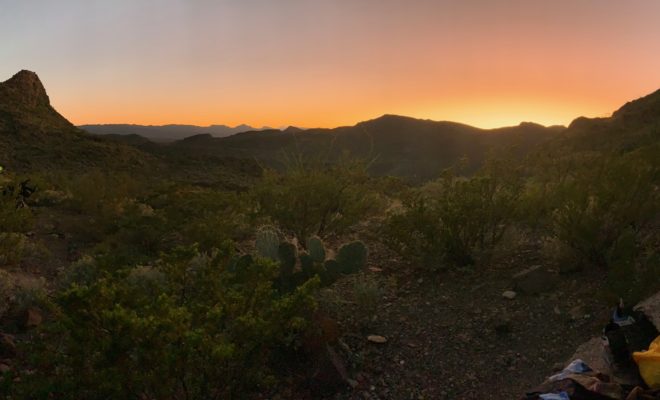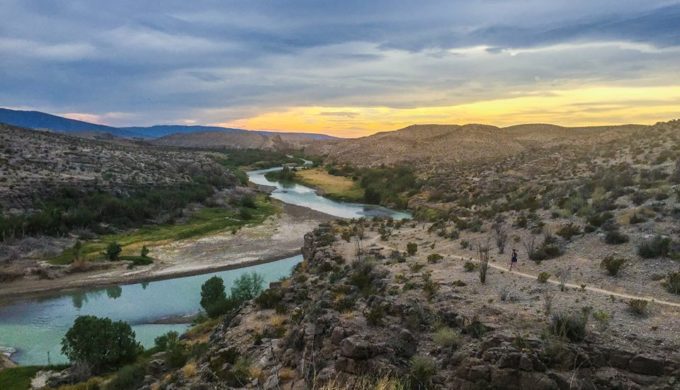The Mountain Bikers
 Photo by Mike Lewis and David Cain
Photo by Mike Lewis and David Cain
Nature
What’s YOUR Big Bend Story? Explore Real Texas Beauty
Eighty miles, three and a half days, (and mountain bikes!) Mike, David, Erik, and Rory, all climbers (ergo, tougher than nails) rode the Epic Plus trail in Big Bend Ranch State Park this October. They carried food and camping gear and were able to replenish water from springs and tanks along the way. With temperatures reaching into the 90’s and no shade, they did most of their riding in the morning. The four adventurers began their trip at the Barton Warnock Center, where they obtained a permit, then headed north on jeep roads. Because of a heavy rain in September, some of the road was washed out and much of it was loose sand, both difficult and impassible on bikes, so some of the time they were “bike packing.” Catclaw, cactus, and yucca growing out onto the trail were a constant threat, threatening to shred their clothes and skin. There are also single-track trails and side loops if riders have time for them. Hikers and bikers can visit the ruins of the old wax factory, mercury mines, and the Crawford-Smith house ruins. Their first camp was in Fresno Canyon, where they marveled at the night sky, with the Milky Way clearly visible and collected water from a small spring. Their second day ride was across an ancient caldera called the Solitario and up a hill on the Road to Nowhere, with camp at Tres Papalotes.

Photo by Mike Lewis and David Cain – Big Bend Ocotillo Flowers
The solar powered well pump there was out of commission, but they were able to get water from the tank. Day three took them to the Sauceda Ranger Station, which has shaded porches, drinking water, free showers, and even WiFi. There is a bunkhouse there, but after spending the afternoon in the shade on the porch, the four rode to their final campsite, Pila de los Muchachos. This is located along the top of a ridge with rocky outcrops and a spectacular sunset. On their way out, one rider wrecked his bike and the others towed him five miles back to the pickup. Mike said, “Be prepared to do some bike mechanic work, use tubeless tires with plenty of sealant and have backup tubes… If you are prepared, it is fantastic fun and one of the most adventurous things you can do in Texas. If you need bike repairs or local advice on biking conditions, contact Mike Long at Desert Sports in Terlingua.”
The Pilots
Bob and Nancy made their first trip to Big Bend last January. They retired a few years ago from farming in the Midwest; both are pilots, and they flew their Piper Dakota (PA-28-236) into the Lajitas International Airport in the Lajitas Golf Resort. There they rented a jeep and toured the National Park, finding that the low speed limit really enhanced their enjoyment of the drive. They stayed in the Lodge in the Chisos Mountains Lodge, where there is a restaurant and a small store, but no cell phone service. Bob stated, “The food was great, and the view of The Window was spectacular! Hiking was good at the Lodge trail-head and we only came across two other hikers on the 1.5-mile loop.” Knowing that Bob and Nancy are both pilots, it’s not surprising that they also took the Lajitas Zip Line tour in Quiet Canyon. They also stayed at the Lajitas Golf Resort, where they arranged for a guided horseback ride. Drinks at La Kiva and dinner at Starlight Theater rounded out their trip. “It was the perfect mid-winter getaway.”

The Canoers
“I’m lucky I’m still alive, frankly!” Bud, an attorney now retired in Fredericksburg, went on a river trip with his son David’s high school class many years ago. The park rangers warned the group about high water, but they continued. Where the Rio Grande enters the Santa Elena Canyon, there is a sharp right turn, and the turbulent water against the steep stone wall of the cliff tipped their canoe over. All were wearing life jackets, and they easily recovered the canoe. The water was fast at the Rockslide half-way through the trip. They scouted the rapid—the preferred route is “left-right-left” around large boulders in the river—and headed into the maelstrom. His canoe turned over at the first obstacle, and he floated down the river in his life jacket, feet-first, bouncing off the boulders in his way. He finally made it to an eddy on the Texas side, but the rest of the group was on the Mexican side. They threw a rope to him, but it was not long enough to reach. A larger raft came by and tried to reach him, but they couldn’t get to river left where he was. A second smaller raft managed to reach him, and after struggling to get the raft off a rock, they went over the next big drop successfully and rejoined his group at the sand bar river right. He will never forget his rescuer, Ron, a FedEx guy from San Antonio. The canoe and others were successfully recovered and the trip continued. “Those guys saved me. That was the last time I went canoeing,” Bud said. For information on floating the river see the Park’s website; there are several outfitters which will put you on the river in a canoe or raft.
The Local
The Marfa Lights are a curiosity with no clear answers. The strange lights have long been reported by both Native Americans and early cowboys. There is no satisfying explanation for them, and I’ll leave the exploration of the possibilities up to you. Now there is a TXDOT built viewing area/restroom complex in the area where locals used to pull off the road to watch for the lights, along US Highway 90, 10 miles east of Marfa toward Alpine. Randall, who owns the iconic and unique Stone Village Tourist Camp and Market in Fort Davis, grew up in the area. He believes the lights are less often seen since the construction of the viewing area. It is an altogether unique Texas experience, and if you want to be a full-fledged Texan, regardless of where you were born, you must spend some time on that viewing deck.

Photo by Mike Lewis and David Cain – Big Bend Mountain Bikers
The Missionaries
Judy, a now-retired nurse in Fredericksburg, made her first trip with the Mision de Candelilla prior to 9/11. Doctors, nurses, other health care providers, and laymen would take a john boat to the Boquillas river crossing in the Big Bend National Park and ferry medical equipment and supplies across to the village of Boquillas. There they would be met by Mexicans with pickup trucks for the trip to the village of Jaboncillos. The group would hold clinics in several villages, working their way back to Boquillas and the Rio Grande crossing, where they would ferry themselves back across the river. After 9/11, they were no longer allowed to cross at Boquillas, so they began driving to Eagle Pass and crossing into Mexico at Piedras Negras, then on to Muzquiz and finally Boquillas. The drive was much longer (13 hours), but the mission had grown larger and it was necessary for them to have their own vehicles. Today the mission provides basic health care three times a year to five villages spread along the Rio Bravo (the Mexican name for the river) in the Big Bend, an area where the people are too poor to travel to the government health care system many miles away. Volunteers find the Chihuahua Desert environment profoundly beautiful, the lack of electricity, cell phone, and internet connections calming, the people charming, and the work rewarding. Boquillas has long been a popular side trip for visitors to the Park. There is now a Boquillas Crossing Point of Entry facility operated by the National Park Service. You will need a passport (birth certificate for children), and the crossing is not open every day; see the Park’s website for details. US Dollars are acceptable currency in the businesses in Boquillas. The river crossing is provided by the village people in rowboats for $5 per person round trip. Even though you may be able to walk across the river nearby, the rowboat trip is a part of the experience not to be missed. Boquillas is ½ mile from the river, and you can walk, or hire a ride on a horse, burro, or pickup truck. Access to these remote villages from inside Mexico involves a long and arduous drive on dirt roads, and the difficult of life on the south side of the Rio Grande will become obvious to the visitor. For the romantic view of this unique experience, listen to Gringo Honeymoon by Robert Earl Keen.
Tell Us YOUR Big Bend Story

Photo by Mike Lewis and David Cain – Big Bend Camp at Sunset
The Big Bend is spectacular but hard. The sun is merciless, the plants all have sharp points, there isn’t much dirt, distances are long, towns few and far between. Locals say, “We only get 10 inches of rain each year, and you ought to be here the day we get it!” If you are thinking of adventuring off the road, consider reading “Death in Big Bend: True Stories of Death & Rescue in the Big Bend National Park” by Laurence Parent before you go. Plan your trip carefully; accommodations for visitors are limited, and campsites and hotel rooms fill up in the very popular week between Christmas and New Year. Fort Davis, Marfa, Alpine, Marathon, Lajitas, Terlingua, Big Bend Ranch State Park, Big Bend National Park – these are the whole ‘nuther part of Texas. What is YOUR Big Bend story?
Originally published in the Winter Issue of Heart of Texas Magazine.


